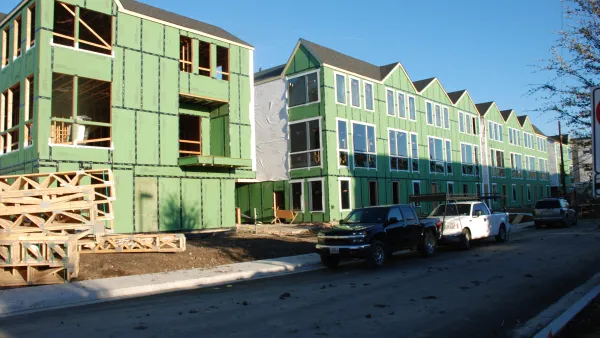Housing advocates praise the city’s move to eliminate single-family zoning by legalizing triplexes on single-family lots, but that isn’t why housing construction is growing.

Christian Britschgi, writing in Reason, claims that the construction boom in Minneapolis is unrelated to the city's decision to remove single-family zoning. “Housing production is up, and rents do indeed appear to be falling. But the effects of Minneapolis' particular means of eliminating single-family-only zoning, and allowing up to triplexes on residential land citywide, have been exceedingly modest.”
Britschgi writes that “from January 2020 through March 2022, Minneapolis approved 62 duplexes and 17 triplexes, according to data collected by the city's Department of Community Planning and Economic Development (CPED). Exactly half of the duplexes and 14 of the triplexes were built on lots that were once zoned for exclusively single-family development.”
“But these two- and three-unit developments still represent a tiny fraction of the roughly 9,000 housing units the city permitted during that same time period.” Emily Hamilton, a housing policy researcher at George Mason University's Mercatus Center, says other constraints prevent the widespread construction of duplexes and triplexes. “There are also restrictions on how large that lot has to be, how large that structure has to be, how much parking is required, and how far a structure has to be from its lot line.” Changes to these policies, says Britschgi, have a more significant impact on new housing production. “[Jason Wittenberg, a planner with CPED] credits the city's elimination of parking minimums—which had typically required one parking spot per housing unit—with facilitating increased construction of smaller apartment buildings.”
Like Minneapolis, cities around the country are moving to reduce or eliminate minimum parking requirements to encourage denser transit-oriented development and bring down the cost of housing production.
FULL STORY: Eliminating Single-Family Zoning Isn't the Reason Minneapolis Is a YIMBY Success Story

National Parks Layoffs Will Cause Communities to Lose Billions
Thousands of essential park workers were laid off this week, just before the busy spring break season.

Retro-silient?: America’s First “Eco-burb,” The Woodlands Turns 50
A master-planned community north of Houston offers lessons on green infrastructure and resilient design, but falls short of its founder’s lofty affordability and walkability goals.

Delivering for America Plan Will Downgrade Mail Service in at Least 49.5 Percent of Zip Codes
Republican and Democrat lawmakers criticize the plan for its disproportionate negative impact on rural communities.

Test News Post 1
This is a summary

Test News Headline 46
Test for the image on the front page.

Balancing Bombs and Butterflies: How the National Guard Protects a Rare Species
The National Guard at Fort Indiantown Gap uses GIS technology and land management strategies to balance military training with conservation efforts, ensuring the survival of the rare eastern regal fritillary butterfly.
Urban Design for Planners 1: Software Tools
This six-course series explores essential urban design concepts using open source software and equips planners with the tools they need to participate fully in the urban design process.
Planning for Universal Design
Learn the tools for implementing Universal Design in planning regulations.
EMC Planning Group, Inc.
Planetizen
Planetizen
Mpact (formerly Rail~Volution)
Great Falls Development Authority, Inc.
HUDs Office of Policy Development and Research
NYU Wagner Graduate School of Public Service





























